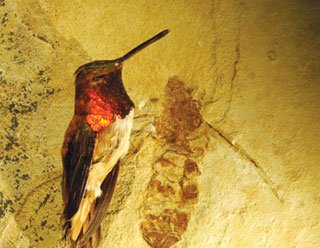Why insects are not as big as people?
Scientists have not yet explained exactly the mechanism behind the limited size of many insects in the modern world.
Director Edgar Wright, famous for comedies like Shaun of the Dead , has announced that he will make a movie about "ants" - a form of comic book superhero that can shrink his body size like ants and comfort. talk to this insect, according to the Grantland news page. If everything can happen as in comics, will ants increase in size and size like people? And why are insects always as small as in the present world?
There is no answer, because no researcher knows exactly how. Currently, experts have only made hypotheses about why insects and arthropods cannot be bigger than their current size.
Too many hypotheses

Ancient ants are as big as hummingbirds
The first hypothesis is that the outer skeleton of the insect is not strong enough, allowing them to be larger than the current body. However, too little empirical evidence for this idea. The only study related to this hypothesis draws the conclusion that large arthropods do not have larger outer bones than small corpses.'So there is no direct evidence to suggest that there is an association between the outer skeleton and the size limit , ' said insectologist Jon Harrison of Arizona State University (USA).
Because of the extra-solid skeleton, insects need to change their hair when they grow up, remove old skin and grow new skin. Scientists believe that this fragile and vulnerable phase has set a ceiling for their size limits: larger organisms, especially those without protective shells, are vulnerable to predators. public.'The bigger you get, the easier it is to become a good prey , ' said Mr. Harrison.
A related hypothesis also suggests that the larger the size, the more dangerous it is for the insect itself, whether or not skin changes. Previous research has found that the size of ancient flies has dropped sharply when birds have grown, thus drawing the conclusion that tiny organisms can hide from predators effectively. Another possibility: insects have an open circulatory system, with blood and body fluids not confined to blood vessels like most vertebrate species. This makes it difficult for the blood to move around the body, because the circulation can be hindered by gravity, pulling the blood downward.
Dragonflies once had a wingspan of 1.8 meters
The most widely accepted hypothesis is the role of oxygen in the blood. Insects 'breathe' through small tubes called trachea, which transfer passive oxygen from the atmosphere to body cells. When insects reach a certain size, the amount of oxygen needs to exceed the ability of the trachea to transfer. This hypothesis seems more reasonable, because about 300 million years ago, many insects were larger than the current descendants. For example, dragonflies must be the size of a buzzard with a distance of 1.8 meters, and a large ant-humming ant, according to a report by the Midwestern University (USA). At that time, the amount of oxygen in the atmosphere had to be 35%, compared with 21% today.
The results of the study by Harrison showed that almost all insects are small in the case of oxygen deficiency, and many species are larger when supplied with more oxygen. In specific species, they can grow 20% in a generation if they live in an oxygen-rich environment. Large insects may also need more airways. However, this hypothesis has not yet been proven.
As mentioned above, scientists still do not understand the mechanism behind insect size limits, or more broadly, the biological foundation that controls body size. In fact, there are still too many questions while the answer is too small. But if ants can be as big as humans, we must not exist today!
- Assassin insects in nature
- Insect-eating insects like to eat
- FAO calls for investment in growing insects for food
- Set of brilliant photos showing off
- Use biological measures against insects
- What will happen if insects disappear from Earth?
- The insects are the most favored of the planet
- How do insects keep their bodies warm?
- Insects also 'love' gay
- More than 1 million species of insects on Earth but this is the reason they are
- Nutritional value in insects comparable to beef
- Insects will be the future food supply?
 Discovered an ancient centipede fossil 99 million years old
Discovered an ancient centipede fossil 99 million years old Discovered bat-like dinosaurs in China
Discovered bat-like dinosaurs in China Discovered a 200-year-old bronze cannon of the coast
Discovered a 200-year-old bronze cannon of the coast Discover 305 million-year-old spider fossils
Discover 305 million-year-old spider fossils